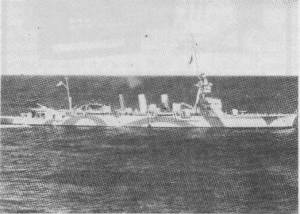- Author
- Gregory, Mackenzie J.
- Subjects
- WWII operations
- Tags
-
- RAN Ships
- HMAS Adelaide I
- Publication
- July 1992 edition of the Naval Historical Review (all rights reserved)
The crew had been promised a new blockade-running medal, in the form of a chain with the picture of BREMEN breaking through to destroy the chain.
ACTION STATIONS
On the 28th November at 1416, ADELAIDE’S mast head lookout reported smoke, 26 degrees on our starboard bow; soon after he reported two masts, and the top of a funnel. Two minutes later, the tops of two masts were visible from the bridge (as a rough guide – one can see the square root of the viewer’s height in feet above the sea’s surface, for example – if the bridge personnel are sixty four feet above the sea – then they will pick up objects eight miles away with the naked eye). ADELAIDE altered course towards this ship and increased speed. At 1422 this unknown vessel turned away, and a few minutes later sent out a distress message ” ‘RRRR TARTYANG’ followed by a suspicious craft”.

No trace of a vessel with that name could be found in any publication we carried.
At 1450, we went to action stations, and all guns that could be brought to bear on our starboard broadside were trained on this ship.
A further distress message sent out on commercial wave length at 1519 was intercepted in ADELAIDE – it read “ ‘RRR TAIYANG’ still chased”
By 1528 we were well placed on her beam to carry out a positive identification.
The Captain was ably assisted by Lieutenant J W Penney his navigating officer, who had served as a Merchant Navy officer and had experience of the construction details of merchant ships. He quickly produced a photograph of the German ship RAMSES from the pack of “German armoured merchant vessels and merchant vessels”. In all essential details this seemed to be the ship under observation.
ADELAIDE was 12,000 yards from RAMSES who was at that stage flying a Norwegian ensign. At 1536 RAMSES was practically stopped and two boats were lowered on the port side.
About eight minutes later an explosion was seen aft in the ship, and a dark cloud of smoke appeared at the stern; the wind quickly blew this smoke so that it covered the whole port side, leaving only the masts and the top of the funnel visible.
ADELAIDE immediately opened fire, as did the HEEMSKERCK by 1551.½ we ceased fire, and RAMSES sank at 1552.
The crew had abandoned ship, except the Captain, the Officer in Charge of the guns crews, and the Wireless Officer who were completing the extensive scuttling arrangements.
However, hits from ADELAIDE’S third salvo quickly hastened their departure.
As RAMSES slipped beneath the sea, her main 6″ armament (the wooden gun) floated off together with its platform.
HEEMSKERCK was ordered to rejoin the convoy, whilst we picked up survivors. Seventy eight crew (now prisoners of war) and ten Norwegian seamen sunk by a German armed raider (now, free men once more) one pig and one dog.
My most vivid memory of this action was some of ADELAIDE’S ships company stopping their hauling in of survivors, to rescue both the pig and the dog before them.
I became very attached to the dog, but after arrival in Fremantle, and disembarking both the POWs and Norwegians, quarantine officers insisted on destroying the dog.
CONCLUSION
Our sharp lookout in ADELAIDE had located RAMSES – quick identification sealed her fate, and the combination of scuttling charges and allied gun fire prevented a valuable cargo reaching Germany, and freed ten Norwegians to fight again, whilst ensuring for seventy eight of her company the war had ended.




